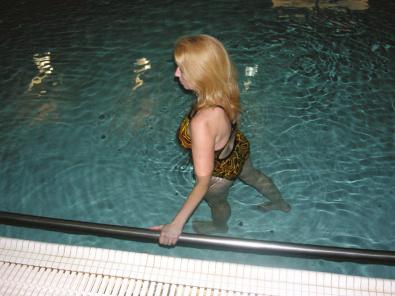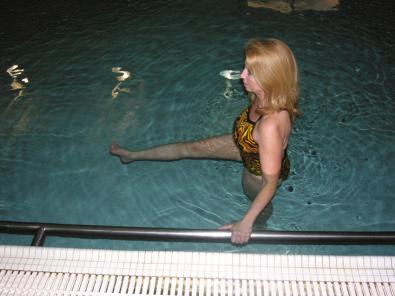Physical Address
304 North Cardinal St.
Dorchester Center, MA 02124
Water has been used for healing, spiritual, and religious purposes since at least 2400 bc . Water was used by the people of Asia to combat fevers as early as 1500 bc . Hippocrates (460-375 BC) used water for relief of muscle spasms and joint pain. For many years, water exercise was dismissed as a medical intervention and considered to be purely recreational. The advent of spas in Europe and around the world moved water-based interventions into the leisure and recreation category, making reimbursement for water-based medical interventions difficult.
Despite a history spanning over 4000 years, a resurgence of aquatics as an intervention has occurred in the past quarter century. Throughout this history, many different terms have been used to describe rehabilitation that takes place in water. Some of these terms include hydrotherapy, aquatic therapy, spa therapy, water therapy, water gymnastics, balneotherapy and pool therapy . The term balneotherapy is distinguished from other forms of hydrotherapy. Balneotherapy refers to the use of hot-water or thermal treatments to decrease pain and stiffness and promote muscle relaxation. Balneotherapy often uses minerals, salts, or sulfur treatments, mud packs, and water jets to achieve these goals. Hydrotherapy is a general term covering any type of water intervention, which might include balneotherapy or exercise. For the purposes of this chapter, the focus remains on the use of exercise in water for the treatment of knee arthritis. For further information on balneotherapy, the reader is referred to Verhagen and coworkers.
Physical therapy for patients with knee arthritis focuses on decreasing pain while improving mobility, muscle performance, motor control, and function. This is often achieved through stretching, strengthening, and balance exercises. However, many patients are unable to perform these exercises on land owing to pain, comorbidities, or other limitations. These patients often do well in an unweighted environment where they are able to perform full range of exercises directed at improved function. Preferably, exercises are not confined to a single environment but represent a comprehensive program of both land-based and water-based rehabilitation. It is not suggested that aquatic rehabilitation results in superior outcomes compared with land-based rehabilitation. Rather, the pool provides an effective, safe alternative for those who cannot tolerate a comprehensive rehabilitation program on land.
The purpose of this chapter is to discuss the scientific basis for rehabilitative exercise in the water, and then apply this information to the treatment of patients with knee arthritis. Understanding the physical properties of water is critical for building a successful rehabilitation program in water. This understanding is both cognitive and kinesthetic. The reader is encouraged to experiment with these properties to fully understand how the body responds differently to exercises in water compared with land.
The scientific foundation for aquatic rehabilitation in patients with arthritic knees is found in two major areas. The first is the basis in aqua physics in which two key forces are critical for treatment planning. The first force is that of buoyancy. Buoyancy is used to unweight an arthritic extremity, normalize gait, and increase pain-free exercise. Buoyancy can also be used as resistance depending on equipment choices and patient positioning. The second force is that of viscosity. Viscosity is used to provide resistance for strengthening muscles from the core to the foot and to provide postural challenges that improve balance. The second major scientific foundational area is that of clinical research in which aquatic rehabilitation has been shown to increase measures of physical performance and to improve patient outcomes.
Buoyancy can unweight an arthritic joint while permitting rehabilitation activities to continue.
The precise amount of weight bearing at any given depth is unknown and is related to the individual's body composition and speed of movement.
Buoyancy can assist, support, or resist a movement depending on how the individual is oriented in the water.
Viscosity can always override buoyancy as resistance if the surface area and speed are great enough.
Hydrostatic pressure can minimize swelling and edema in the lower limb that can occur with land-based exercise.
Hydrostatic pressure causes a centralization of peripheral blood flow with subsequent changes in the pulmonary and heart blood volumes.
Heart rates for exercise while immersed to the neck will be approximately 20 beats/min lower than comparable land-based exercise owing to hydrostatic pressure.
The principles supporting the use of water in rehabilitation are based in physics. Several physical properties of water are key to understanding how water is a useful exercise mode for people with arthritis of the knee. Capitalizing on these properties can increase the opportunity for a successful outcome for these patients with complicated problems. Failure to recognize or understand how these principles work in harmony or in opposition can lead to poor outcomes. The key properties include buoyancy, hydrostatic pressure, and viscosity.
Buoyancy is the upward thrust experienced during immersion that is in direct opposition to gravity. Buoyancy is used to unload the lower extremity from the effects of gravity, making it a useful tool for those with knee arthritis. Archimedes' principle states that an immersed body, at rest, experiences an upward thrust equal to the weight of the same fluid volume it displaces.
Buoyancy is related to a person's specific gravity (SG), which varies with body composition. Any object with an SG of less than 1.0 g/cm 2 will float, whereas any object with an SG greater than 1.0 g/cm 2 will sink. This property forms the basis of underwater weighing to determine body composition. Because lean body mass is heavier than fat mass, those with high lean body mass tend to sink, and those with greater fat mass float. This fact makes it difficult to know precisely how much weight bearing any given individual is achieving at a given water depth. Harrison and Bulstrode performed studies on percentage weight bearing during static standing in various water depths ranging from the hips to the neck. The authors found considerable variability in the amount of weight bearing with immersion at various depths. This variation might have been partly caused by using a fixed-depth pool and only nine subjects. However, the disparity may also be the result of differences in body composition and body fat distribution among individual study subjects, suggesting that weight-bearing prescription is difficult in this medium. A follow-up study by Harrison and associates showed that compared with static standing, fast walking increased weight-bearing forces up to 76%. Understanding Archimedes' principle highlights the difficulties in assigning a specific percentage of weight bearing at any given depth; the weight on the limb will vary with body composition and speed of movement.
The moment of buoyancy is also important in exercise prescription. As with moments of gravity on land, the moment of buoyancy increases with increasing lever arm length and nearer the parallel. If the movement is in an upward direction, the same direction as the force of buoyancy, the activity is considered to be buoyancy assisted . If the movement in toward the pool bottom in opposition to buoyancy, it is considered to be buoyancy resisted . Movements parallel to the bottom that are neither assisted nor resisted by buoyancy are considered buoyancy-supported exercises. For example, in a standing position, a straight-leg lift forward would be assisted by buoyancy, whereas the return motion back to the neutral position would be buoyancy resisted. In a supine position, hip abduction and adduction would be buoyancy-supported activities. An important application of this information is strengthening hip extensor muscles. In a standing position, the motion of hip extension from neutral to 15 degrees extension (the normal range of hip extension) occurs through such a small range of motion (ROM), with a short moment arm, and is buoyancy assisted, making the exercise a little more than a gluteal isometric exercise ( Fig. 34-1 ). However, the motion from 90 degrees of hip flexion returning to neutral is also hip extension but is now moving through a larger range with a longer moment arm against the upward force of buoyancy, making this an effective hip extensor muscle-strengthening exercise ( Fig. 34-2 ).


Pascal's law states that a fluid exerts pressure equally on an object at a given depth. Hydrostatic pressure increases with a greater depth of immersion owing to the weight of the volume of fluid overhead. The increased hydrostatic pressure close to the bottom of the pool assists venous return to the heart and prevents fluid accumulation in the lower extremities. This is useful for people with knee or ankle arthritis, who tend to experience swelling with exercise. The increased venous return to the heart also affects the cardiorespiratory system. The hydrostatic pressure when the body is immersed to the neck produces an increase in heart volume, intrapulmonary blood volume, right atrial pressure, left ventricular end-diastolic volume, stroke volume, and cardiac output. Heart rate is unchanged or decreased compared with similar land-based activities. Peripheral circulation and vital capacity are decreased. This cardiopulmonary response is significant for people with cardiorespiratory conditions and for those who are trying to achieve training heart rates in deep-water exercise. These changes have been noted in people both with and without cardiac disease. Aerobic exercise in neck-deep water will result in heart rates that are approximately 17 to 20 beats/min lower than comparable land-based exercise.
Become a Clinical Tree membership for Full access and enjoy Unlimited articles
If you are a member. Log in here